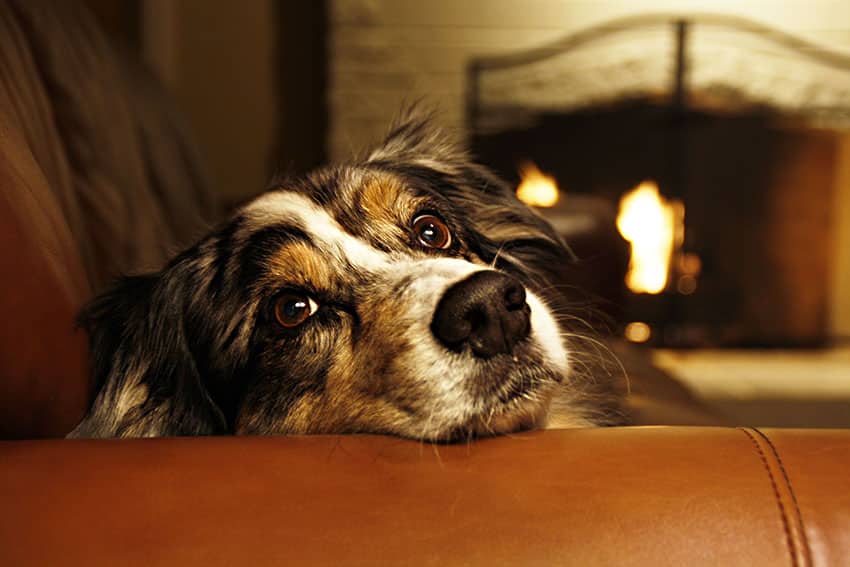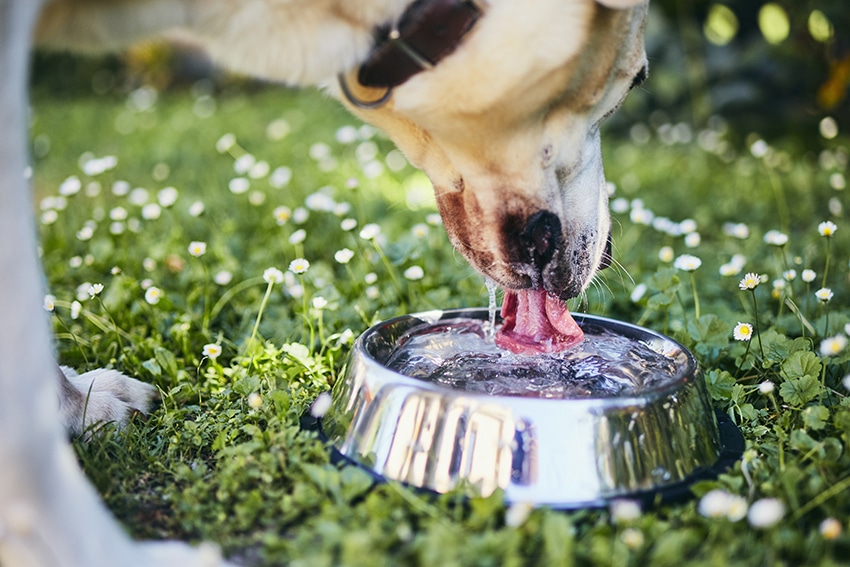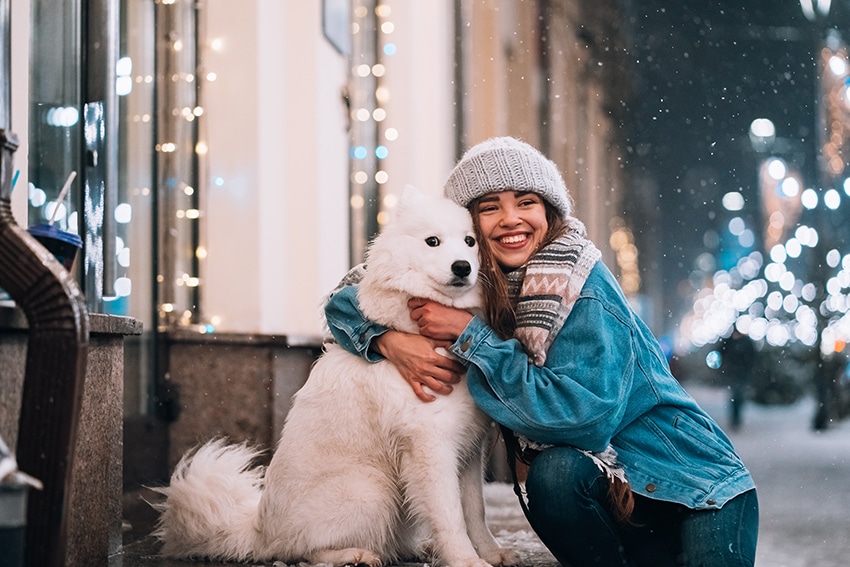Dog Winter Safety Guide: Get Ready for Snow, Cold Weather & Winter Hazards
Winter is just around the corner, and where I live that means snow and some frigid temperatures. Humans in the midwest know how to prepare for the outdoors. We don wool socks, wear insulated boots, and layer our clothes to avoid frostbite and hypothermia. But our furbabies may need some help.
For starters, it’s best to keep your pups indoors in the extreme cold, such as sub-zero Fahrenheit temperatures. This is especially true for puppies, dogs with health issues, and seniors. These pooches often lack the fat layer, thick fur coat, or metabolism they need to stay warm when the temperatures plummet.
As for other furbabies…you still want to minimize outside time during the deep freeze particularly if there are wind chill advisories. The air feels colder in windy conditions, and even the hardiest of dogs can rapidly suffer from hypothermia or frostbite.
In the case of hypothermia, your pup’s body temperature can drop below the normal range (101 – 102.5 F) and affect the central nervous system. Signs of hypothermia include pronounced shivering, labored breathing, a weak thready pulse, stiffness, and lethargy.
For frostbite, a section of the skin or body freezes. This is most common with extremities like the ear flaps, tail, or footpads. The skin will initially appear pale and shriveled but will later become red, swollen, and sensitive to touch.
If you live in a climate that includes frosty weather, you may be wondering what can you do to keep your canine companion safe. In this post, we’ll look at some winter safety tips for your dog. Let’s get started:
Use Temperature Appropriate Attire

Unless you have a breed that’s made for arctic conditions, such as a Saint Bernard or Great Pyrenees, you may want to invest in a sweater for your pooch. Dogs with thin hair coats can benefit from an extra layer of protection from the elements. The best outerwear will go from the neck to the tail head and also protect the belly area.
Of course, a dog sweater sill leaves the tail, ears, and feet unprotected. So, you’ll still want to limit your outdoor time to protect your furry friend from frostbite.
Go Out in Daylight

If you have a pooch that’s sensitive to freezing temperatures, plan your walks for the warmer parts of the day. Try to get out in the late morning or early afternoon rather than around dawn or dusk. Remember to take extra advantage of sunny days. Plan short play sessions in the sunshine to get a dose of vitamin D for you and your furry friend. Use a safe fetch toy such as a frisbee or ball.
Provide Warm Bedding

It’s essential to offer your special pal the right bedding to keep him warm in the winter. Sleeping on cold floors can be hard on senior canines. Offer cozy blankets and/or a raised bed to protect from the chilly ground. A heating pad may help ease joint stiffness for elderly pups. You’ll also want to locate Fido’s nest in a favorite resting spot and away from drafts to maximize his comfort. If your pooch is an outdoor dog, provide a safe dog-house heater to help keep his home comfortable.
Protect Your Pal From Heaters

Who doesn’t like to snuggle by the fire on a chilly night? Canines, like humans, tend to get closer to heat sources when they’re feeling cold. Huddling too close to heaters or fires can dry out the skin, cause burns, or singe the hair. You protect your furry friend by putting covers over baseboard radiators, using fireplace screens, and avoiding space heaters or at least setting up a pet-proof barrier.
Use Pet-Safe Moisturizers

The air gets drier when temperatures plunge. You can protect your pooch from flaky, dry skin with oral supplements that support healthy skin and hair. Add some coconut oil to the diet. This ingredient also works as a topical moisturizer for exposed skin on the belly, ears, paws, and tail.
Provide Plenty of Potable Water

With the dry air, dogs can rapidly become dehydrated in the winter if they spend time playing in the yard. Even if your pup likes to gulp snow, he’ll need a bowl of water that’s readily available. Make sure outside dishes are full and don’t have a layer of ice on top.
Snow Maintenance

Much like children, our furbabies frequently love to frolic in fresh snow. But there are risks with the white precipitation. When you clear patios and walkways to prevent slippery surfaces, be mindful of where you locate the snow piles. It’s important to avoid putting mounds next to your fencing. It creates an escape route, and that can be tempting for even the best-trained pooch.
It’s also important to clear snow from your roof. The blanket may look nice, but when the sun warms the surface, you can get an avalanche of ice and snow. Your pooch could be injured by the falling materials if he’s by the eaves. If you can’t reach the roof with a snow rake, keep your four-footed friend away from the roof overhang areas.
Winter Travels

You’ve likely heard how dangerous it can be to leave your pooch in a car in the summer. The same principle goes for the cold. As a matter of fact, there’s no good season to leave a dog alone in the car. In winter, the interior temperature of a vehicle can plummet in extreme cold, and leaving the engine running can put your pal at risk from dangerous fumes like carbon monoxide. If you’re running errands, leave your pup at home where he’s warm and safe.
Winter Hygiene

It’s best to keep bathing to a minimum in the winter months. Washing your pup’s fur removes important oils from the skin surface, and it takes time for the body to replenish them. Frequent baths will increase the risk of dry, flaky skin. If you need to shampoo your pup, ask your veterinarian for recommendations about good moisturizing products that can nourish the integument while gently cleansing the hair.
Protect the Footpads

Sometimes we use salt or other chemicals to help with snow and ice removal, and these products can be harmful to your pup’s feet. Choose pet-safe ice melt products as much as possible on your property. To help guard the skin, apply petroleum jelly or another paw protectant to the footpads before your furry friend goes out for a walk. You can also invest in booties that cover the foot and prevent salt or sand from lodging between Fido’s toes.
Increase Caloric Content

When the environmental temperature drops, your pooch has to use more energy to stay warm. Boost your pal’s caloric content by supplementing his diet. A little extra weight can help provide a layer of insulation, but be careful not to overdo it. You don’t want your pup to become obese.
Watch Out for Antifreeze

Antifreeze is a deadly poison for dogs. It can take less than three ounces to cause kidney failure. That’s why you should store this liquid safely and be vigilant. Watch your pup carefully on walks and don’t let him lick anything off the road.
The chemical may be a fluorescent green or some other color. We commonly use it in our car radiators, and some people pour it down their toilet to winterize pipes. If a dog ingests antifreeze, you may notice signs such as drooling, vomiting, wobbly/drunken gait, depression, knuckling over of the feet, seizures, excessive thirst, or panting. If you notice these symptoms, call your vet immediately.
Keep the Paws Clean

If your pal doesn’t have booties, wash his paws when you come in from a walk. That way you’ll remove salt and other chemicals from the footpads, and you’ll be able to inspect your pup’s feet for any irritations, redness, or cracks in the pads. Consider bringing a towel with you for longer outings so that you can wipe feet along the way if your pooch shows signs that something is irritating his paws.
Don’t Shave Your Dog

Even if your furbaby has long tresses that can collect furballs, don’t shave him to the skin. Leave a longer hair coat for extra insulation and just trim back the long feathers. If you have a short-haired furbaby, invest in a high-necked sweater that reaches to the tail base and covers the belly area.
Humidify Your Home

Humidified air can help your pooch recover from the frigid outdoor temperatures. It also counteracts the arid conditions of colder air and may prevent dry, flaky skin. Keep your indoors comfortable, and remember to towel dry your pooch when they come inside. Don’t forget to check between the toes for snow or ice chunks.
Consider Outdoor Attire

If you have a senior dog, a small breed, or a pup with a short hair coat, make sure they’re warm enough for wintry conditions. Many times, older dogs don’t have as much fat or muscle to help insulate them from a harsh environment. Diminutive pooches have more surface area per pound, so they lose body heat faster. In both cases, adding an extra layer can help them stay comfy and safe during a walk.
Trim Between the Toes

Fur can act as a snow and ice magnet. When you’re doing touch-up grooming, make sure you trim the hair between the toes. Keep the fur even with the footpad surface to allow for insulation without providing a spot for ice balls to form.
Don’t Tread on Thin Ice

If you live in the land of winter ice fishing and snowmobiles, it’s imperative that you check the ice before letting your dog stop onto a frozen lake or pond. Yes, it’s fun to slide across the surface, but thin ice can crack and cause you and your furbaby to take an arctic plunge. Know the general guidelines for ice thickness and color to help you determine if it’s safe.
If the ice is thick enough to support your weight, you should still proceed with caution. It’s easy to slip or fall on the slick surface, and you or your pal could strain a muscle or sustain other injuries.
Set the Thermostat for Your Dog’s Comfort Zone

It’s important to heat your home to a comfortable temperature for you and your pets. To save money on the heating bill, we may want to turn the heat down and add extra clothing layers. But when we make the home too cold for our pooches, it can affect their health. If your furbaby can’t get and stay warm, he may be more prone to illness, arthritis aches and pains, or other cold-induced issues.
Your pal’s comfort zone will depend on his breed, age, size, hair length, and other factors. However, at humidity levels between 30 and 70%, the normal temperature range is about 68-86 degrees F. So, as long as you keep the air humidified and provide free access to water, you can help your pooch stay healthy and prevent dry, cracked skin by maintaining a moderate temperature.
Stick Close

It’s easier for dogs to lose a scent track when it’s covered with a layer of snow or ice. When you take your pal out for a romp, make sure you can see him at all times. If the weather is blustery or there’s a snowstorm keep him on a leash. That way, your pal won’t become confused and wander away from you. Always make sure your special pal has an ID tag for extra protection in case you become separated.
Be Visible After Dark

Even though it’s best to take advantage of the sun, it may not be possible during daylight savings time. If you have to walk your pooch after dark, invest in reflective gear such as a vest for yourself and a leash, harness, and collar for your pup. You’ll also want to keep Fido close by your side if you’re walking on the road to boost his visibility with drivers.
Be Emergency-Ready

Wicked winter weather can trigger power outages and other emergency situations. Make sure you have a plan for you and your pets. Pack a kit with blankets, food, water, and any needed medicines. Include enough vital supplies for at least 5 days. You’ll also want some first-aid supplies handy in case your dog needs basic initial care. Even if you never need it, you’ll have the peace of mind knowing that you’re ready.
Consider Your Senior

Senior dogs need special care in winter weather. Frigid temperatures can intensify arthritis symptoms as well as those of some other conditions. Maintaining regular exercise can help ease joint pain, but be careful about ice and slippery surfaces. Provide warm, supportive bedding for rest and recuperation after your outings. If you don’t already use one, adding a naturally-sourced joint supplement can help support orthopedic health. You’ll also want to be alert to any changes in your pal’s energy level and attitude as he’ll be more susceptible to illness in extreme weather.
Be Proactive About Your Dog’s Winter Safety

The harsh conditions that frequently come with winter can mean added challenges for you and your pooch. Whether you’re dealing with icy temperatures, wind chills, or cold wet rain that chills to the bone, these situations can be uncomfortable or downright dangerous for your dog. That’s why you need to be vigilant about your furbaby’s health and safety in winter.
By following these tips and paying close attention to your pup, you should be able to get the most out of the season. And of course, take advantage of those chilly evenings by snuggling with your four-footed friend to stay warm and cozy!
